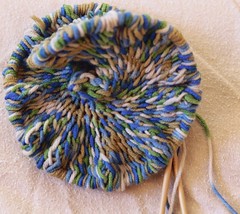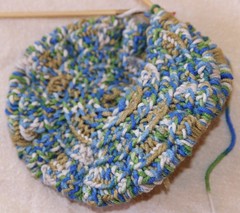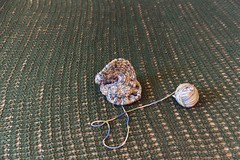Ah, brave, new year, which doth clutch me to its thin, ascetic breast!
All hail the month of diets! Success to Maki, a most excellent food writer who is now going to make an awe-inspiring attempt to stop food obsessing and lose weight. With such inspiration, we lesser mortals surely cannot fail. Since we still have to eat, though, I’ve decided it’s soup time, and in honor of the god Janus, and his apparent amused affection for the devotion of starving, cranky people, I’m going to try to make broccoli soup — sans eggs, parmesan, Gruyère, butter, and cream — and still make it tasty. (Isn’t it sad that the list of ingredients I’m leaving OUT sound so tasty!? Bring on the white wine and mustard, and we can just have some kind of pasta. Oooh, yum.)
 First, may I just say that broccoli is world’s nastiest vegetable when it’s overcooked!? Which, sadly probably happens every fifteen seconds in our fair state, not to mention around the world. To get around the idea of gross-green-soup-of-overcooked-veg, I’ve thought to roast the broccoli first. It’s not that novel an idea – it’s just laziness, really, calling me. I’m reading Diana Wynn Jones. I’m having a lovely old escapist, childhood time. I don’t want to be bothered. That’s why God made oven timers…
First, may I just say that broccoli is world’s nastiest vegetable when it’s overcooked!? Which, sadly probably happens every fifteen seconds in our fair state, not to mention around the world. To get around the idea of gross-green-soup-of-overcooked-veg, I’ve thought to roast the broccoli first. It’s not that novel an idea – it’s just laziness, really, calling me. I’m reading Diana Wynn Jones. I’m having a lovely old escapist, childhood time. I don’t want to be bothered. That’s why God made oven timers…
So, here’s the plan: I chop up two heads of broccoli, peel the stems (there’s good stuff in there, according to my Food Boyfriend Jacques, and anyway it’s wasteful to not use such hugely menacing stalks when I won’t even have to look at them or even chew.) add some garlic, some shallots and/or garlic cloves, spritz lightly with oil, and let them go in a 400° oven for twenty minutes, then stir, and let them go another ten. After that, it’s a small and simple matter to put the limp veg into the blender and beat them to death, while boiling up your soup base. My soups tend to be non cream-based, and since I’m making a creamy broccoli soup, not cream of broccoli, I will just use a bouillon cube, 1/4 cup of wine, 1 c. water, and 1 tsp. of diluted cornstarch or arrowroot powder. 
My only slight concern is the color… I have to admit some squeamishness regarding baby-poo colored broccoli soup, and since I used a leftover purple cauliflower, we’re already having some color, erm, issues… I have a feeling that in the end the soup will oxidize slightly once cooked and whizzed down. I don’t know where I get this idea; broccoli seems to be entirely impervious to anything else like, oh, bugs and things in the garden — it’s tough as nails, generally, so I don’t know why I think it will fall apart and go brown on me, but I’m sure I’m just repressing some awful vegan-childhood experience… at any rate, I am hoping that the wine will help keep the color intact, but just to be in the safe side, I’ll squeeze a couple of limes into the whole thing, garnish with chili flakes and then a few dry-fried shallots on top. I can top it with plain yogurt or cottage cheese and feel virtuous.
Unless I thaw out one of those fabulous rosemary flatbreads Mac made and top it with cheese and veg and for all intents and purposes turn my ascetic soup meal into soup with PIZZA…
Ahem. Not that that’s going to happen. For another hour or so…
Cheers!







 with his penchant for flinging fleshy huge mushrooms in EVERYTHING, or mi mama, with that unholy Creole trinity of green bell peppers, onions and celery — and I loathe bitter green bells and celery cooked. Shudder. Those were the soups of my childhood — limp, overcooked vegetables in a watery broth; or horrible broccoli soups with garish flavors all competing; soups layered with some floaty unidentifiable green stuff with a green bitterness undergirding it all. Long ago I determined that these are not the soups I will spend my adult life eating.
with his penchant for flinging fleshy huge mushrooms in EVERYTHING, or mi mama, with that unholy Creole trinity of green bell peppers, onions and celery — and I loathe bitter green bells and celery cooked. Shudder. Those were the soups of my childhood — limp, overcooked vegetables in a watery broth; or horrible broccoli soups with garish flavors all competing; soups layered with some floaty unidentifiable green stuff with a green bitterness undergirding it all. Long ago I determined that these are not the soups I will spend my adult life eating.
























 decided, since I have an abundance of carrots and leeks from the farm box this week, to see if they’d make a decent soup. I tasted a piece of the top, and determined that it was a flavor close enough to celery to work well.
decided, since I have an abundance of carrots and leeks from the farm box this week, to see if they’d make a decent soup. I tasted a piece of the top, and determined that it was a flavor close enough to celery to work well.